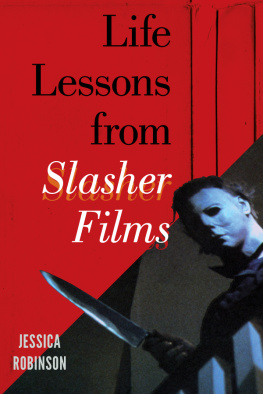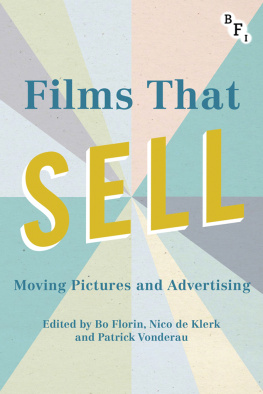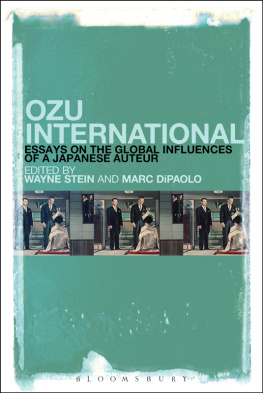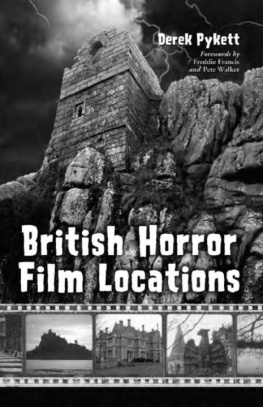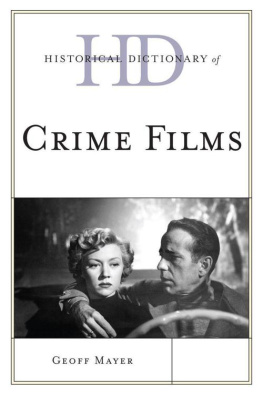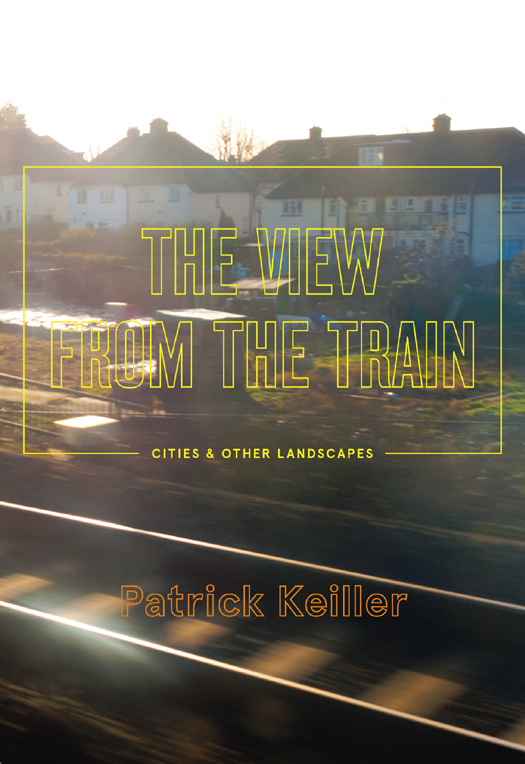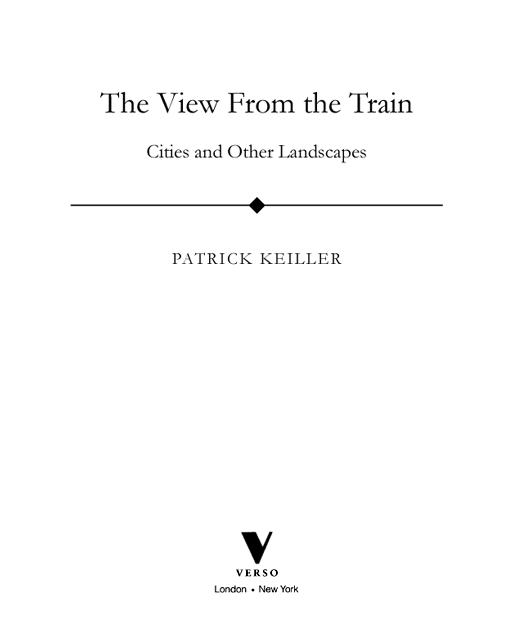First published by Verso 2013
Patrick Keiller 2013
All photographs and film frames are by Patrick Keiller unless otherwise noted
All rights reserved
The moral rights of the author have been asserted
Verso
UK: 6 Meard Street, London W1F 0EG
US: 20 Jay Street, Suite 1010, Brooklyn, NY 11201
www.versobooks.com
Verso is the imprint of New Left Books
ISBN (US): 9781781681961
ISBN (UK): 9781781685051
British Library Cataloguing in Publication Data
A catalogue record for this book is available from the British Library
Library of Congress Cataloging-in-Publication Data
Keiller, Patrick.
The view from the train : cities and other landscapes / by Patrick Keiller. pages cm
ISBN 978-1-78168-140-4 (hardback)
eBook ISBN: 978-1-78168-196-1
1. London (England)In motion pictures. 2. London (England)In art.
3. LandscapesGreat BritainIn art. I. Title.
PN1995.9.L57K45 2013
791.4309421dc23
2013024703
v3.1
Contents
Introduction
The View from the Train
In 1977, I embarked on a project identifying and photographing what I later came to call found architecture. I had lived in London for ten years and was becoming familiar with the citys geography. Living near Parliament Hill, working in Clapham, teaching part-time in Walthamstow and visiting sites over much of south London, I travelled between all these places, often, by motorcycle, and on these and similar journeys had encountered a variety of buildings and other structures with striking architectural qualities that were, mostly, not the result of conventional architectural activity. I decided to celebrate my first decade in London by making 35mm colour transparencies of these buildings, and any others that I might notice. I saw them initially as possible models for architectural production, as early twentieth-century modernists regarded some industrial and other structures, but they also seemed to admit the possibility of a more inclusive transformation of everyday surroundings, and I began to think they might be subjects for cinematography.
In January 1978, the exhibition Dada and Surrealism Reviewed opened at the Hayward Gallery. In its catalogue, and more particularly in an article by Roger Cardinal, Soluble City: The Surrealist Perception of Paris, in Surrealism and Architecture, a special issue of Architectural Design that accompanied the exhibition, I read about the Surrealists adoption of various sites and structures in Paris in the 1920s. It seemed to me that my identification of sites in London in the 1970s could be seen as something similar. I began to take my slide collection more seriously, and in the autumn of 1979 it was the starting point of a two-year postgraduate project in Peter Kardias Department of Environmental Media at the Royal College of Art. After a difficult year confronting a previously overlooked lack of technique, I assembled a series of monochrome slides of landscapes photographed in France during the summer of 1980 and wrote a five-minute narration to accompany them. I made another five-minute photo-narrative with photographs of a tall wall next to a car park on Wormwood Scrubs, behind the prison, and then, on a Sunday afternoon in December, set out to look for a possible camera subject that I had seen from a passing train, where I found a structure that prompted a film.

Demolition of cattle market shed, La Villette, Paris, September 1980
While I was writing the narration for the film Robinson in Ruins (2010), I remembered that I had first seen the final destination of its exploratory journey from a passing train, so that I have produced, so far, a body of work that begins and ends with views from trains.
The second essay here was written in 1983, while I was editing a second film, Norwood (1984), photographed entirely in Norwood. The essay added Thomas De Quinceys Confessions of an English Opium-Eater to the references assembled by its predecessor. During the rest of the decade, I was making or writing proposals for films, while teaching two or three days a week, and there were no more essays for some time. I made three more short films, the first of which was photographed in September 1983, on eight 100-foot rolls of 16mm monochrome negative, during a journey with my partner and sometime collaborator Julie Norris to Italy, via Belgium, Germany and Switzerland. This footage eventually became a third film, The End (1986), the model for all its successors in that it was the first in which narration was written for an already-edited montage. The previous two films had been assemblies of a few long takes for which it was fairly easy to write continuous narrative, but in The End, most of the camera subjects appear only briefly.
Its completion was delayed by an unrealised project for a film about the life and work of the architect Adolf Loos, conceived after another journey, to Czechoslovakia in 1984, where we had visited some little-known Loos buildings. This was the first of several projects for more serious films in which I hoped to re-engage with architecture. It was a collaboration with Yehuda Safran, who had been one of my tutors at the RCA, and Stuart Hood, who had just produced a film about Dario Fo for Channel Four Television. While I had migrated from architecture to art, Yehuda had been travelling in the opposite direction, and was by then involved with the architecture journal 9H.open at the Museum of Modern Art in Oxford in October 1985. When we returned from Czechoslovakia, I had the idea I might be able to make a film to accompany the exhibition. The initial proposal attracted some development finance, but none of the likely institutional patrons could be persuaded to commission the film.
Another of these would-be scholarly projects was for a film about the Devtsil, the Czechoslovakian avant-garde of the 1920s, and would have accompanied an exhibition that we had seen, then in preparation, on a second visit to Czechoslovakia, to Prague, Brno and Bratislava, in 1986: a two-week British Council academic exchange to study Czechoslovakian modern architecture of the 1920s and 30s. I was interested to examine any relationship between Surrealism and architectural practice: although the Surrealists in Paris had been interested in urban space and architecture, none of them were architects, but the Devtsil, the precursor of Czech Surrealism, included several architects, among them Jaromr Krejcar (18951949), the designer of the Czechoslovak pavilion at the 1937 Paris World Exhibition. The history of Czech modernism was then still largely unknown in English-speaking countries; and gave a copy of the Devtsil catalogue to David Elliott, the director of the Museum of Modern Art in Oxford, where the exhibition opened in March 1990. The proposal for the film was developed with Keith Griffiths, later the producer of London. I returned to Prague in April 1994, for a conference of which there are some traces in the essay Popular Science, written five years later.
I had completed The End in the summer of 1986. It was selected for the Edinburgh Film Festival; some drawings I had made as aids to writing the narration were included in a touring exhibition that opened at the Serpentine Gallery, and in 1987 Channel Four bought the UK television rights. It was followed by two competitively won commissions for short films co-funded by Channel Four, the second of which was made for the British Film Institute and led to the opportunity to develop


